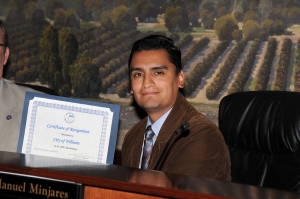|
City debuts Economic Development Strategic Plan
By Jean McLeod — Wednesday, October 29th, 2014
 Mayor Manuel Minjares displays a Proclamation from the Ventura Regional Sanitation District to the City of Fillmore recognizing the town’s 100 Year Centennial at Tuesday night’s council meeting. The October 28, 2014 Fillmore City Council Meeting began with Mayor Manuel Minjares displaying a Proclamation from the Ventura Regional Sanitation District to the City of Fillmore recognizing the town's 100 Year Centennial. The Council then gave unanimous approval to the first agenda item; a completed Economic Development Strategic Plan presented to them by City Manager David W. Rowlands. The Plan covers a wide breadth of actions for the City to pursue and was haled as forward thinking. Council Member Rick Neal responded, "This is a great step in the right direction." The second agenda item was presented by Finance Director Gaylynn Brien on Fillmore's updated Investment Policy and asked for approval of Multi-Bank Securities, Inc (MBS) to conduct investment activities for the City of Fillmore. Brien explained the research she did to qualify MBS and that the firm is "a highly thought of brokerage dealer with 20 years of working with city governments." The expected return on investments is 2.4% to 2.5% with a 5 year ladder instead of 2 years. Council Member Rick Neal said he was pleased that MBS was a service and not a contract company, and as a provider Fillmore could change source at any time. Council Member Diane McCall told Brien she was also pleased saying "...we're not tied into a contract" and that she appreciated all Brien's research. Council Member Douglas Tucker responded, "It looks like a low risk, with a higher rate of return." The third and forth agenda items were requests by Planning and Community Development Director Kevin McSweeney regarding contracting out to perform development application support, plan check review, inspections, preparation of records, water/sewer and public improvements. The cost of both one year contracts ($20,000 and the second is not to exceed $100,000) will be paid by the applicant/developer with McSweeney managing the contracts. Conaway responded, "This is a very common practice in cities with a small staff. Hiring a reputable firm is a way to be builder-friendly and get things moving." The last agenda item was an unfunded mandate from the State of California and presented by Michael Lapraik, Fillmore's new City Engineer. Lapraik informed the Council that Federal and State regulations are requiring that Fillmore prepare an implementation plan for the Storm Drain Bacteria Total Maximum Daily Load (Bacteria TMDL) limitations on the Santa Clara River (SCR). Back in September 2012 the City of Fillmore entered into Memorandum of Agreement (MOA) with Santa Paula, Oxnard, Ventura and County unincorporated areas to monitor and study the bacteria levels of the SCR. That MOA expired June 30, 2014. The total cost for the study was $65,023 with Fillmore paying $13,205. The results of the monitoring revealed SCR has high bacterial levels. Now the State wants the cities involved to present a plan on how they will achieve compliance with Bacteria TMDL. The plan must be submitted by March 21, 2015 and include implementation strategies, implementation schedule, proposed milestones and monitoring. In February 2013 Fillmore was asked to fund research with Ventura, Santa Paula and Piru in the Lower Santa Clara River Groundwater Basins Salt and Nutrient Management Plan Development Group (all those towns that run along the Santa Clara River) in developing a regional plan to help recycle water from waste water. This was part of the State Water Resource Control Board (SWRC) Policy of encouraging the use of recycled water from waste water sources as a safe alternative water supply. The goal being to increase the use of recycled water over 2002 levels by one million acres-foot per year by 2020 and two million acre-foot by 2030. SWRC went forward with this plan and due to some areas along the river having higher salts and nutrients SWRC determined the cities should work together to help cover costs. In August of 2011 a cost sharing plan of 25% matching funds from those participating was established along with $397,000 in grant funding through Proposition 84. Participants were required to provide $134,530 (Fillmore's share was $10,762) of the $531,530 total cost of the project. The total cost of this latest mandate is $207,543 with no grants available for the work. The five MOS's will equally divide 20% of the cost for project management and common aspects of implementation, with the remaining 80% shared based on their jurisdictional land area. Fillmore, with the smallest share of land will pay $25,735. During Public Comments Marie Wren addressed the problem of loitering on Central Avenue. "It's the little things that disturb seniors," Wren said and went on to explain how she observed people (tourists) on Central avoiding the area close to the post office and tobacco shop due to the men sitting on the brick wall. "People are intimidated by the loitering." Wren also asked what could be done to stop cars from turning around mid-block on Central Ave. Later in the meeting Fillmore Police Chief David Wareham commented on the "creative measures" to be soon implemented; such as playing music to dissuade loitering in certain areas where businesses are affected by it. |
